Unit 4: Leadership and Management Report - Tesco's Operations
VerifiedAdded on 2023/06/10
|17
|4851
|85
Report
AI Summary
This report provides a comprehensive analysis of leadership and management practices within Tesco, a major global retailer. It begins with an introduction to Tesco's organizational structure and then defines and differentiates the roles of managers and leaders, highlighting their distinct functions and responsibilities. The report explores the application of management and leadership roles in various organizational situations, supported by relevant theories and concepts. It delves into the planning, organizing, staffing, coordinating, and controlling functions within Tesco, examining how leadership styles and management theories, such as Classical Management Theory, Contingency Theory, and Management by Objective Theory, are applied. The report evaluates the strengths and weaknesses of different leadership and management approaches, drawing conclusions to support leadership theories and offering recommendations for future improvements within Tesco's operations. The analysis emphasizes the impact of leaders and managers on organizational outcomes and suggests strategies for enhancing operational efficiency and effectiveness.
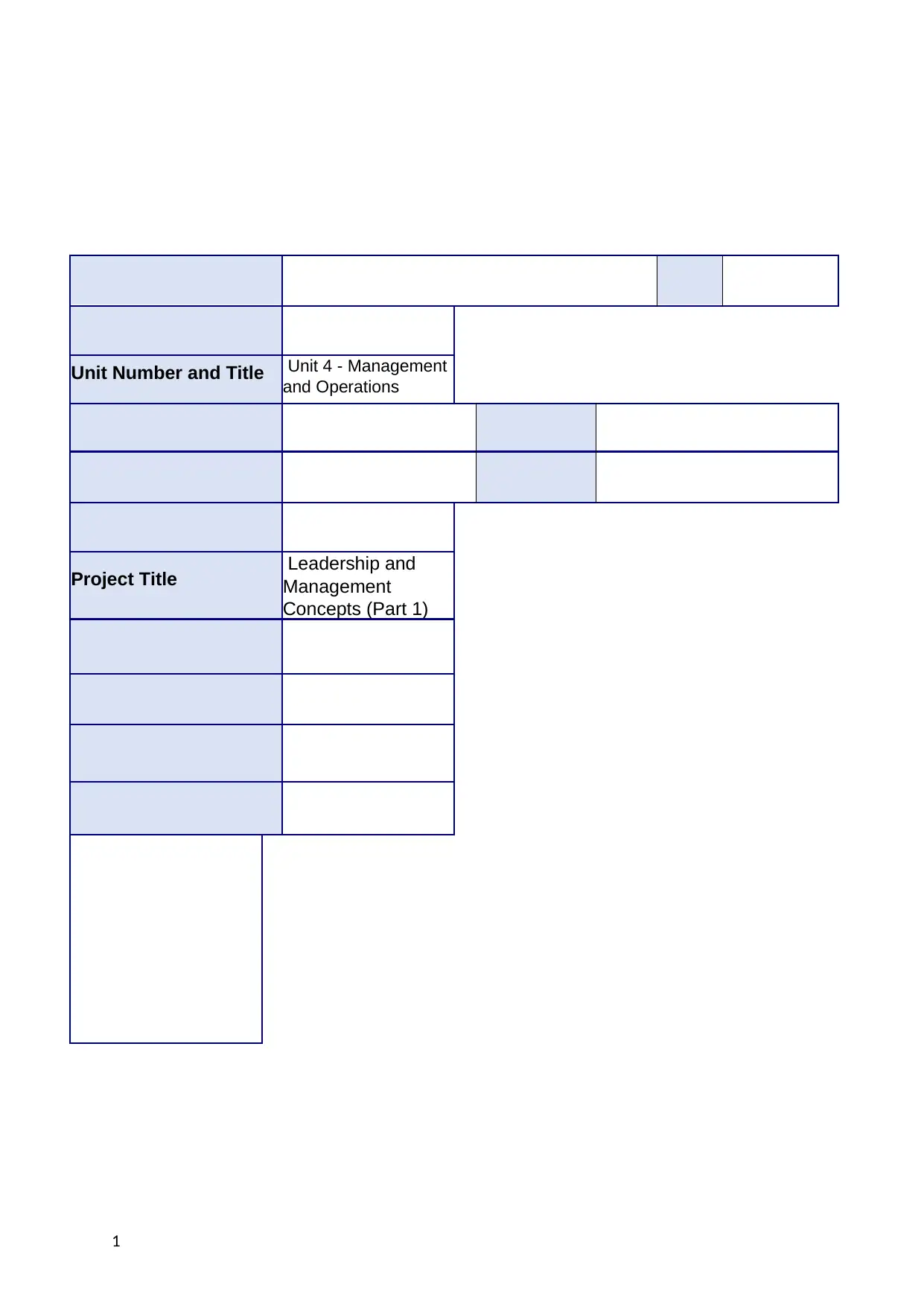
Unit Number and Title Unit 4 - Management
and Operations
Project Title Leadership and
Management
Concepts (Part 1)
1
and Operations
Project Title Leadership and
Management
Concepts (Part 1)
1
Paraphrase This Document
Need a fresh take? Get an instant paraphrase of this document with our AI Paraphraser
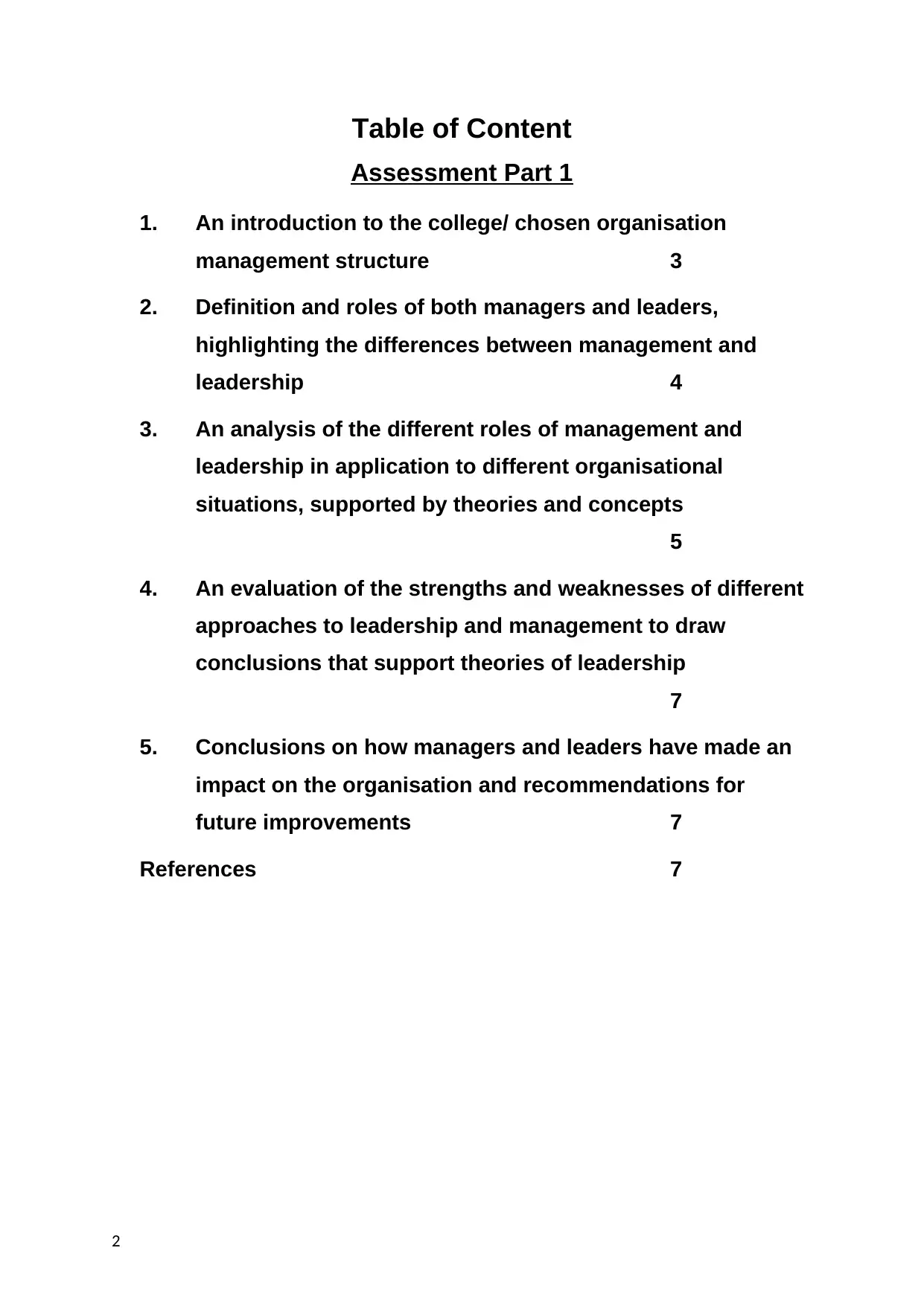
Table of Content
Assessment Part 1
1. An introduction to the college/ chosen organisation
management structure 3
2. Definition and roles of both managers and leaders,
highlighting the differences between management and
leadership 4
3. An analysis of the different roles of management and
leadership in application to different organisational
situations, supported by theories and concepts
5
4. An evaluation of the strengths and weaknesses of different
approaches to leadership and management to draw
conclusions that support theories of leadership
7
5. Conclusions on how managers and leaders have made an
impact on the organisation and recommendations for
future improvements 7
References 7
2
Assessment Part 1
1. An introduction to the college/ chosen organisation
management structure 3
2. Definition and roles of both managers and leaders,
highlighting the differences between management and
leadership 4
3. An analysis of the different roles of management and
leadership in application to different organisational
situations, supported by theories and concepts
5
4. An evaluation of the strengths and weaknesses of different
approaches to leadership and management to draw
conclusions that support theories of leadership
7
5. Conclusions on how managers and leaders have made an
impact on the organisation and recommendations for
future improvements 7
References 7
2
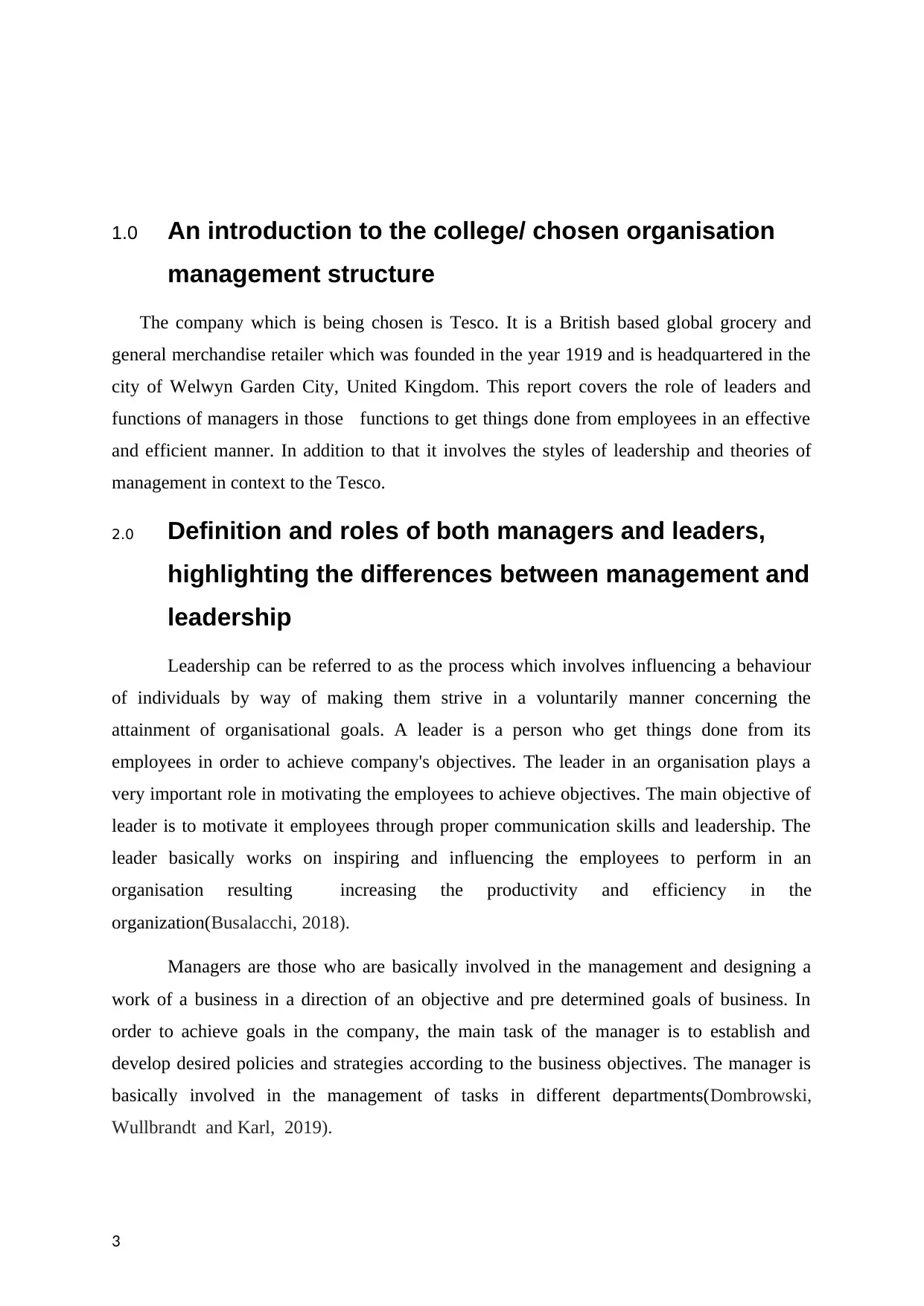
1.0 An introduction to the college/ chosen organisation
management structure
The company which is being chosen is Tesco. It is a British based global grocery and
general merchandise retailer which was founded in the year 1919 and is headquartered in the
city of Welwyn Garden City, United Kingdom. This report covers the role of leaders and
functions of managers in those functions to get things done from employees in an effective
and efficient manner. In addition to that it involves the styles of leadership and theories of
management in context to the Tesco.
2.0 Definition and roles of both managers and leaders,
highlighting the differences between management and
leadership
Leadership can be referred to as the process which involves influencing a behaviour
of individuals by way of making them strive in a voluntarily manner concerning the
attainment of organisational goals. A leader is a person who get things done from its
employees in order to achieve company's objectives. The leader in an organisation plays a
very important role in motivating the employees to achieve objectives. The main objective of
leader is to motivate it employees through proper communication skills and leadership. The
leader basically works on inspiring and influencing the employees to perform in an
organisation resulting increasing the productivity and efficiency in the
organization(Busalacchi, 2018).
Managers are those who are basically involved in the management and designing a
work of a business in a direction of an objective and pre determined goals of business. In
order to achieve goals in the company, the main task of the manager is to establish and
develop desired policies and strategies according to the business objectives. The manager is
basically involved in the management of tasks in different departments(Dombrowski,
Wullbrandt and Karl, 2019).
3
management structure
The company which is being chosen is Tesco. It is a British based global grocery and
general merchandise retailer which was founded in the year 1919 and is headquartered in the
city of Welwyn Garden City, United Kingdom. This report covers the role of leaders and
functions of managers in those functions to get things done from employees in an effective
and efficient manner. In addition to that it involves the styles of leadership and theories of
management in context to the Tesco.
2.0 Definition and roles of both managers and leaders,
highlighting the differences between management and
leadership
Leadership can be referred to as the process which involves influencing a behaviour
of individuals by way of making them strive in a voluntarily manner concerning the
attainment of organisational goals. A leader is a person who get things done from its
employees in order to achieve company's objectives. The leader in an organisation plays a
very important role in motivating the employees to achieve objectives. The main objective of
leader is to motivate it employees through proper communication skills and leadership. The
leader basically works on inspiring and influencing the employees to perform in an
organisation resulting increasing the productivity and efficiency in the
organization(Busalacchi, 2018).
Managers are those who are basically involved in the management and designing a
work of a business in a direction of an objective and pre determined goals of business. In
order to achieve goals in the company, the main task of the manager is to establish and
develop desired policies and strategies according to the business objectives. The manager is
basically involved in the management of tasks in different departments(Dombrowski,
Wullbrandt and Karl, 2019).
3
⊘ This is a preview!⊘
Do you want full access?
Subscribe today to unlock all pages.

Trusted by 1+ million students worldwide
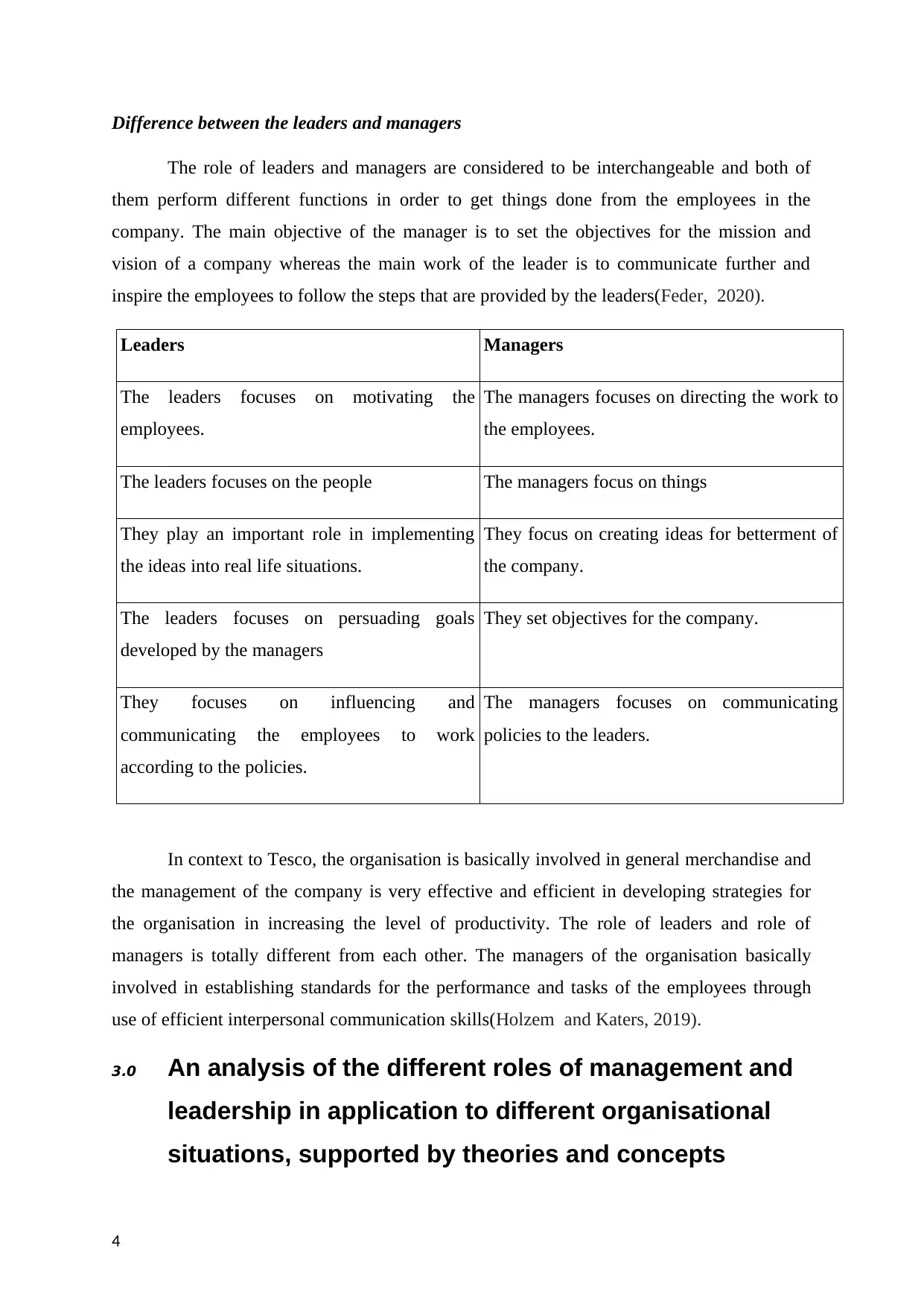
Difference between the leaders and managers
The role of leaders and managers are considered to be interchangeable and both of
them perform different functions in order to get things done from the employees in the
company. The main objective of the manager is to set the objectives for the mission and
vision of a company whereas the main work of the leader is to communicate further and
inspire the employees to follow the steps that are provided by the leaders(Feder, 2020).
Leaders Managers
The leaders focuses on motivating the
employees.
The managers focuses on directing the work to
the employees.
The leaders focuses on the people The managers focus on things
They play an important role in implementing
the ideas into real life situations.
They focus on creating ideas for betterment of
the company.
The leaders focuses on persuading goals
developed by the managers
They set objectives for the company.
They focuses on influencing and
communicating the employees to work
according to the policies.
The managers focuses on communicating
policies to the leaders.
In context to Tesco, the organisation is basically involved in general merchandise and
the management of the company is very effective and efficient in developing strategies for
the organisation in increasing the level of productivity. The role of leaders and role of
managers is totally different from each other. The managers of the organisation basically
involved in establishing standards for the performance and tasks of the employees through
use of efficient interpersonal communication skills(Holzem and Katers, 2019).
3.0 An analysis of the different roles of management and
leadership in application to different organisational
situations, supported by theories and concepts
4
The role of leaders and managers are considered to be interchangeable and both of
them perform different functions in order to get things done from the employees in the
company. The main objective of the manager is to set the objectives for the mission and
vision of a company whereas the main work of the leader is to communicate further and
inspire the employees to follow the steps that are provided by the leaders(Feder, 2020).
Leaders Managers
The leaders focuses on motivating the
employees.
The managers focuses on directing the work to
the employees.
The leaders focuses on the people The managers focus on things
They play an important role in implementing
the ideas into real life situations.
They focus on creating ideas for betterment of
the company.
The leaders focuses on persuading goals
developed by the managers
They set objectives for the company.
They focuses on influencing and
communicating the employees to work
according to the policies.
The managers focuses on communicating
policies to the leaders.
In context to Tesco, the organisation is basically involved in general merchandise and
the management of the company is very effective and efficient in developing strategies for
the organisation in increasing the level of productivity. The role of leaders and role of
managers is totally different from each other. The managers of the organisation basically
involved in establishing standards for the performance and tasks of the employees through
use of efficient interpersonal communication skills(Holzem and Katers, 2019).
3.0 An analysis of the different roles of management and
leadership in application to different organisational
situations, supported by theories and concepts
4
Paraphrase This Document
Need a fresh take? Get an instant paraphrase of this document with our AI Paraphraser
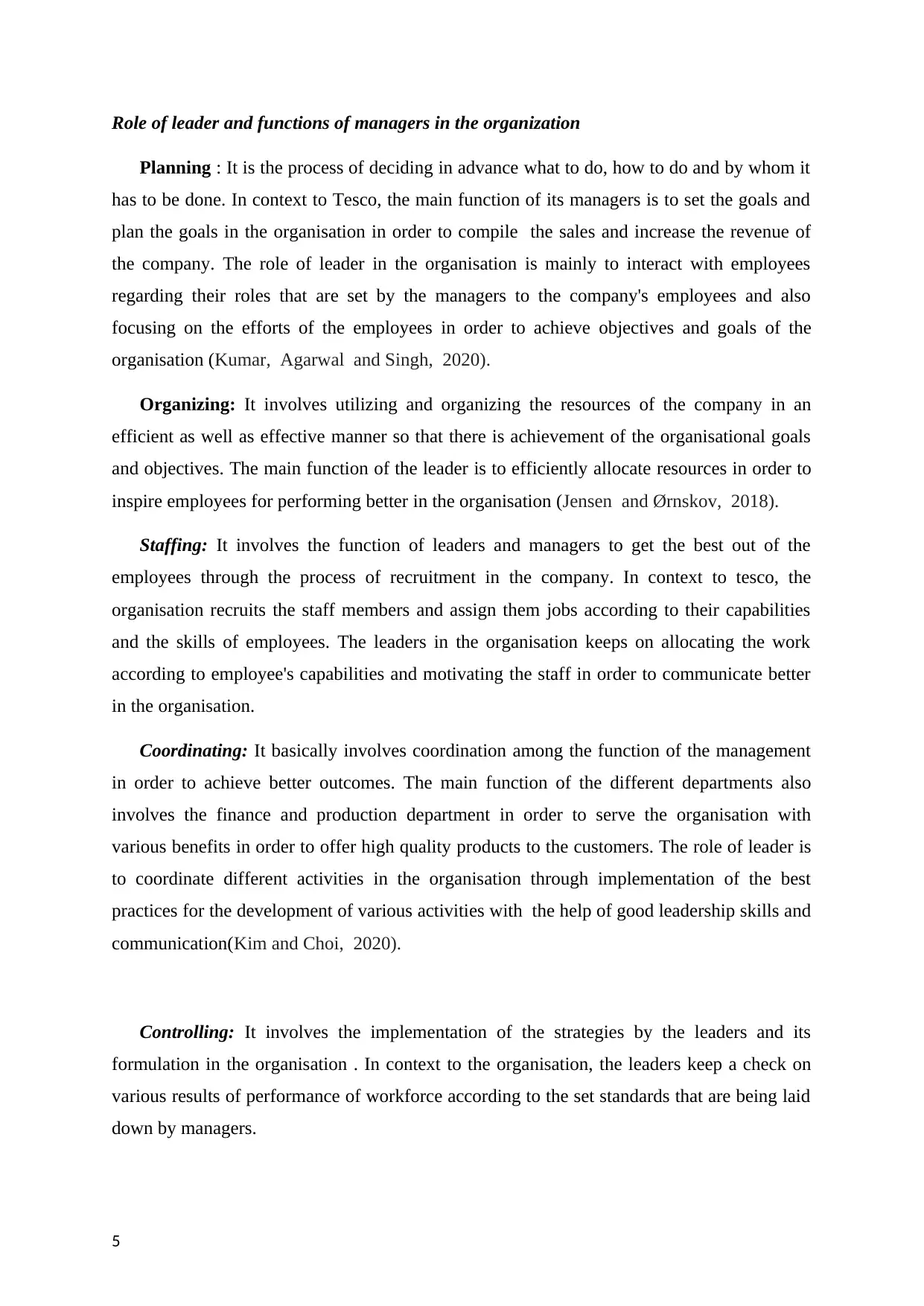
Role of leader and functions of managers in the organization
Planning : It is the process of deciding in advance what to do, how to do and by whom it
has to be done. In context to Tesco, the main function of its managers is to set the goals and
plan the goals in the organisation in order to compile the sales and increase the revenue of
the company. The role of leader in the organisation is mainly to interact with employees
regarding their roles that are set by the managers to the company's employees and also
focusing on the efforts of the employees in order to achieve objectives and goals of the
organisation (Kumar, Agarwal and Singh, 2020).
Organizing: It involves utilizing and organizing the resources of the company in an
efficient as well as effective manner so that there is achievement of the organisational goals
and objectives. The main function of the leader is to efficiently allocate resources in order to
inspire employees for performing better in the organisation (Jensen and Ørnskov, 2018).
Staffing: It involves the function of leaders and managers to get the best out of the
employees through the process of recruitment in the company. In context to tesco, the
organisation recruits the staff members and assign them jobs according to their capabilities
and the skills of employees. The leaders in the organisation keeps on allocating the work
according to employee's capabilities and motivating the staff in order to communicate better
in the organisation.
Coordinating: It basically involves coordination among the function of the management
in order to achieve better outcomes. The main function of the different departments also
involves the finance and production department in order to serve the organisation with
various benefits in order to offer high quality products to the customers. The role of leader is
to coordinate different activities in the organisation through implementation of the best
practices for the development of various activities with the help of good leadership skills and
communication(Kim and Choi, 2020).
Controlling: It involves the implementation of the strategies by the leaders and its
formulation in the organisation . In context to the organisation, the leaders keep a check on
various results of performance of workforce according to the set standards that are being laid
down by managers.
5
Planning : It is the process of deciding in advance what to do, how to do and by whom it
has to be done. In context to Tesco, the main function of its managers is to set the goals and
plan the goals in the organisation in order to compile the sales and increase the revenue of
the company. The role of leader in the organisation is mainly to interact with employees
regarding their roles that are set by the managers to the company's employees and also
focusing on the efforts of the employees in order to achieve objectives and goals of the
organisation (Kumar, Agarwal and Singh, 2020).
Organizing: It involves utilizing and organizing the resources of the company in an
efficient as well as effective manner so that there is achievement of the organisational goals
and objectives. The main function of the leader is to efficiently allocate resources in order to
inspire employees for performing better in the organisation (Jensen and Ørnskov, 2018).
Staffing: It involves the function of leaders and managers to get the best out of the
employees through the process of recruitment in the company. In context to tesco, the
organisation recruits the staff members and assign them jobs according to their capabilities
and the skills of employees. The leaders in the organisation keeps on allocating the work
according to employee's capabilities and motivating the staff in order to communicate better
in the organisation.
Coordinating: It basically involves coordination among the function of the management
in order to achieve better outcomes. The main function of the different departments also
involves the finance and production department in order to serve the organisation with
various benefits in order to offer high quality products to the customers. The role of leader is
to coordinate different activities in the organisation through implementation of the best
practices for the development of various activities with the help of good leadership skills and
communication(Kim and Choi, 2020).
Controlling: It involves the implementation of the strategies by the leaders and its
formulation in the organisation . In context to the organisation, the leaders keep a check on
various results of performance of workforce according to the set standards that are being laid
down by managers.
5
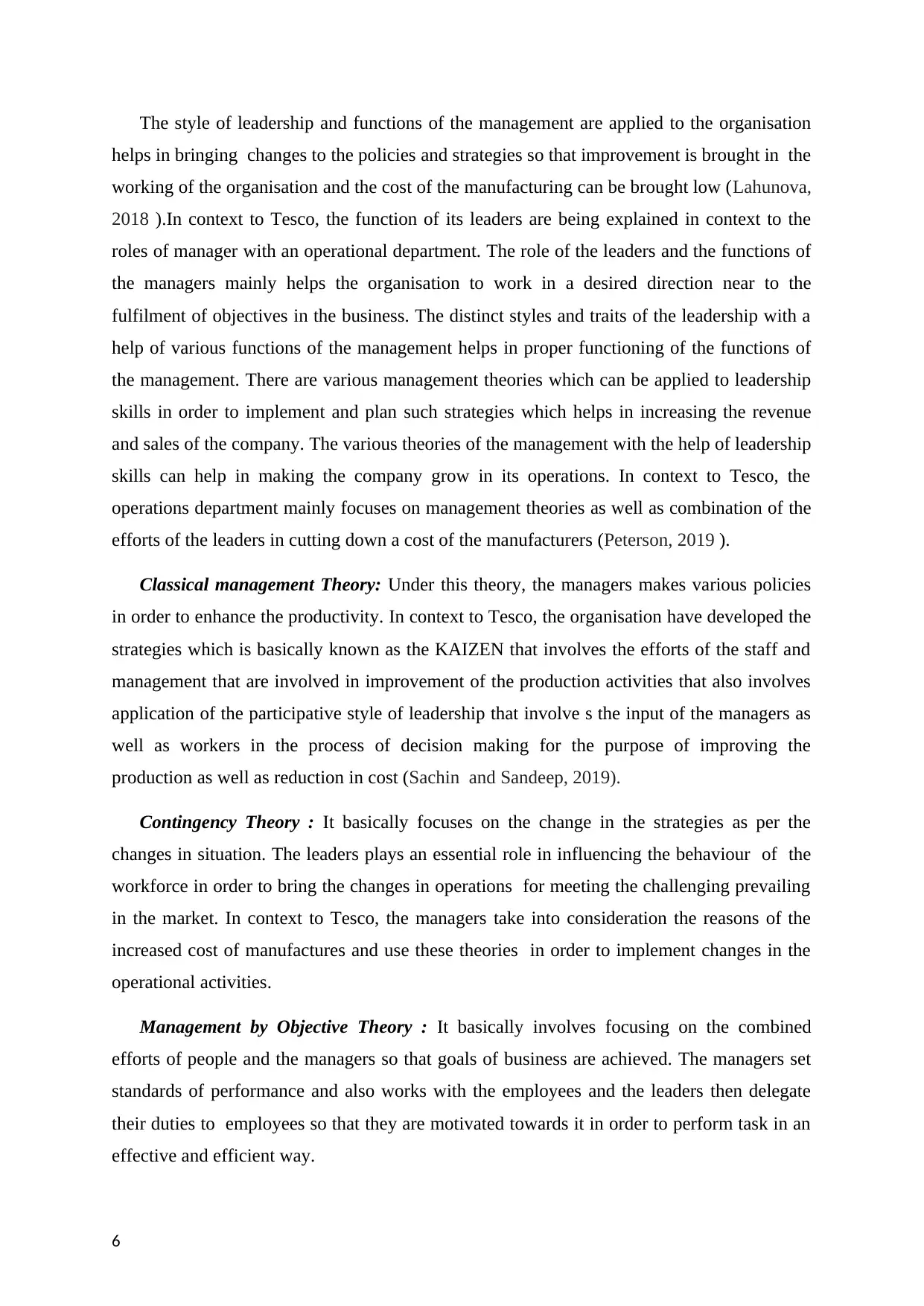
The style of leadership and functions of the management are applied to the organisation
helps in bringing changes to the policies and strategies so that improvement is brought in the
working of the organisation and the cost of the manufacturing can be brought low (Lahunova,
2018 ).In context to Tesco, the function of its leaders are being explained in context to the
roles of manager with an operational department. The role of the leaders and the functions of
the managers mainly helps the organisation to work in a desired direction near to the
fulfilment of objectives in the business. The distinct styles and traits of the leadership with a
help of various functions of the management helps in proper functioning of the functions of
the management. There are various management theories which can be applied to leadership
skills in order to implement and plan such strategies which helps in increasing the revenue
and sales of the company. The various theories of the management with the help of leadership
skills can help in making the company grow in its operations. In context to Tesco, the
operations department mainly focuses on management theories as well as combination of the
efforts of the leaders in cutting down a cost of the manufacturers (Peterson, 2019 ).
Classical management Theory: Under this theory, the managers makes various policies
in order to enhance the productivity. In context to Tesco, the organisation have developed the
strategies which is basically known as the KAIZEN that involves the efforts of the staff and
management that are involved in improvement of the production activities that also involves
application of the participative style of leadership that involve s the input of the managers as
well as workers in the process of decision making for the purpose of improving the
production as well as reduction in cost (Sachin and Sandeep, 2019).
Contingency Theory : It basically focuses on the change in the strategies as per the
changes in situation. The leaders plays an essential role in influencing the behaviour of the
workforce in order to bring the changes in operations for meeting the challenging prevailing
in the market. In context to Tesco, the managers take into consideration the reasons of the
increased cost of manufactures and use these theories in order to implement changes in the
operational activities.
Management by Objective Theory : It basically involves focusing on the combined
efforts of people and the managers so that goals of business are achieved. The managers set
standards of performance and also works with the employees and the leaders then delegate
their duties to employees so that they are motivated towards it in order to perform task in an
effective and efficient way.
6
helps in bringing changes to the policies and strategies so that improvement is brought in the
working of the organisation and the cost of the manufacturing can be brought low (Lahunova,
2018 ).In context to Tesco, the function of its leaders are being explained in context to the
roles of manager with an operational department. The role of the leaders and the functions of
the managers mainly helps the organisation to work in a desired direction near to the
fulfilment of objectives in the business. The distinct styles and traits of the leadership with a
help of various functions of the management helps in proper functioning of the functions of
the management. There are various management theories which can be applied to leadership
skills in order to implement and plan such strategies which helps in increasing the revenue
and sales of the company. The various theories of the management with the help of leadership
skills can help in making the company grow in its operations. In context to Tesco, the
operations department mainly focuses on management theories as well as combination of the
efforts of the leaders in cutting down a cost of the manufacturers (Peterson, 2019 ).
Classical management Theory: Under this theory, the managers makes various policies
in order to enhance the productivity. In context to Tesco, the organisation have developed the
strategies which is basically known as the KAIZEN that involves the efforts of the staff and
management that are involved in improvement of the production activities that also involves
application of the participative style of leadership that involve s the input of the managers as
well as workers in the process of decision making for the purpose of improving the
production as well as reduction in cost (Sachin and Sandeep, 2019).
Contingency Theory : It basically focuses on the change in the strategies as per the
changes in situation. The leaders plays an essential role in influencing the behaviour of the
workforce in order to bring the changes in operations for meeting the challenging prevailing
in the market. In context to Tesco, the managers take into consideration the reasons of the
increased cost of manufactures and use these theories in order to implement changes in the
operational activities.
Management by Objective Theory : It basically involves focusing on the combined
efforts of people and the managers so that goals of business are achieved. The managers set
standards of performance and also works with the employees and the leaders then delegate
their duties to employees so that they are motivated towards it in order to perform task in an
effective and efficient way.
6
⊘ This is a preview!⊘
Do you want full access?
Subscribe today to unlock all pages.

Trusted by 1+ million students worldwide
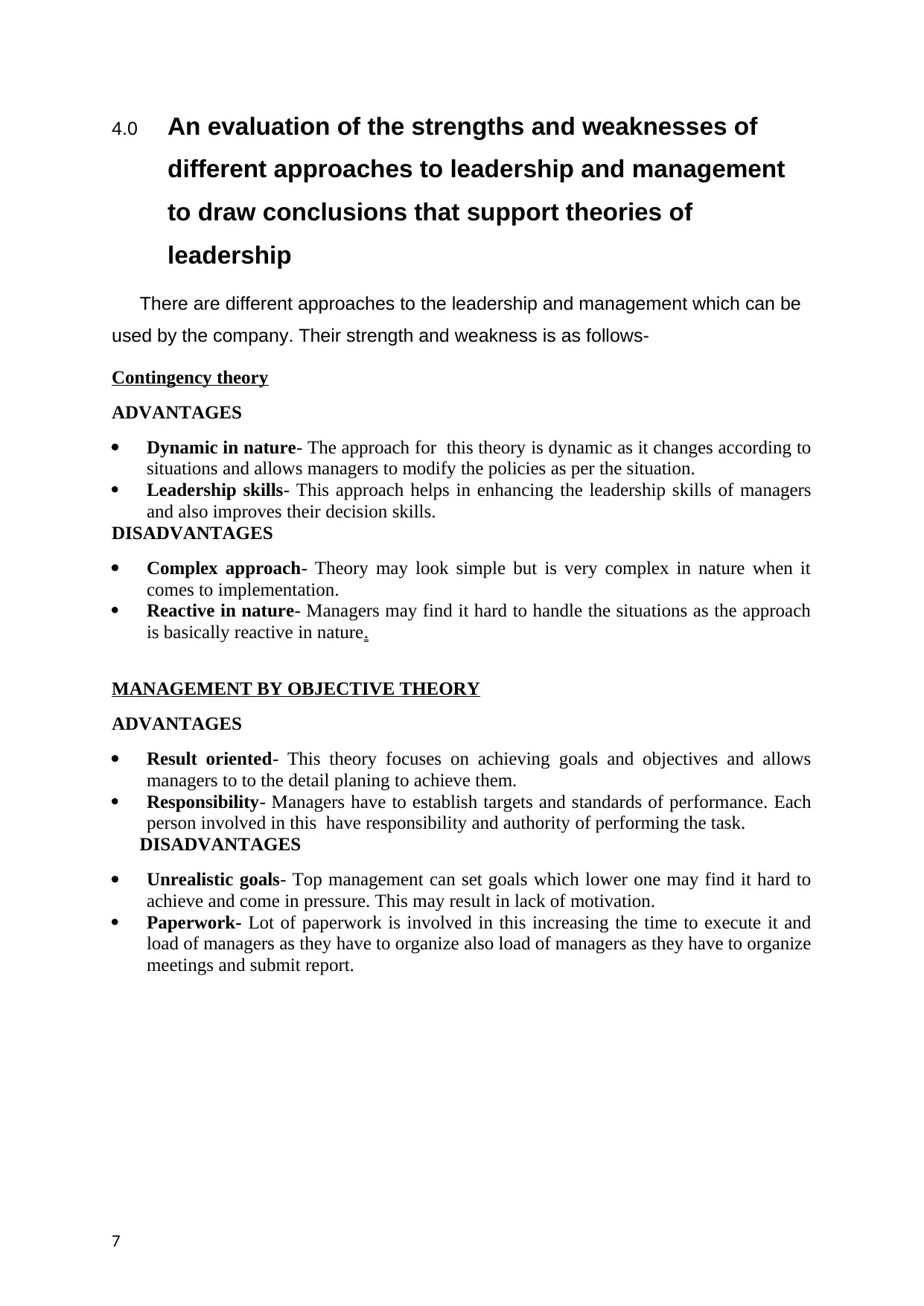
4.0 An evaluation of the strengths and weaknesses of
different approaches to leadership and management
to draw conclusions that support theories of
leadership
There are different approaches to the leadership and management which can be
used by the company. Their strength and weakness is as follows-
Contingency theory
ADVANTAGES
Dynamic in nature- The approach for this theory is dynamic as it changes according to
situations and allows managers to modify the policies as per the situation.
Leadership skills- This approach helps in enhancing the leadership skills of managers
and also improves their decision skills.
DISADVANTAGES
Complex approach- Theory may look simple but is very complex in nature when it
comes to implementation.
Reactive in nature- Managers may find it hard to handle the situations as the approach
is basically reactive in nature.
MANAGEMENT BY OBJECTIVE THEORY
ADVANTAGES
Result oriented- This theory focuses on achieving goals and objectives and allows
managers to to the detail planing to achieve them.
Responsibility- Managers have to establish targets and standards of performance. Each
person involved in this have responsibility and authority of performing the task.
DISADVANTAGES
Unrealistic goals- Top management can set goals which lower one may find it hard to
achieve and come in pressure. This may result in lack of motivation.
Paperwork- Lot of paperwork is involved in this increasing the time to execute it and
load of managers as they have to organize also load of managers as they have to organize
meetings and submit report.
7
different approaches to leadership and management
to draw conclusions that support theories of
leadership
There are different approaches to the leadership and management which can be
used by the company. Their strength and weakness is as follows-
Contingency theory
ADVANTAGES
Dynamic in nature- The approach for this theory is dynamic as it changes according to
situations and allows managers to modify the policies as per the situation.
Leadership skills- This approach helps in enhancing the leadership skills of managers
and also improves their decision skills.
DISADVANTAGES
Complex approach- Theory may look simple but is very complex in nature when it
comes to implementation.
Reactive in nature- Managers may find it hard to handle the situations as the approach
is basically reactive in nature.
MANAGEMENT BY OBJECTIVE THEORY
ADVANTAGES
Result oriented- This theory focuses on achieving goals and objectives and allows
managers to to the detail planing to achieve them.
Responsibility- Managers have to establish targets and standards of performance. Each
person involved in this have responsibility and authority of performing the task.
DISADVANTAGES
Unrealistic goals- Top management can set goals which lower one may find it hard to
achieve and come in pressure. This may result in lack of motivation.
Paperwork- Lot of paperwork is involved in this increasing the time to execute it and
load of managers as they have to organize also load of managers as they have to organize
meetings and submit report.
7
Paraphrase This Document
Need a fresh take? Get an instant paraphrase of this document with our AI Paraphraser
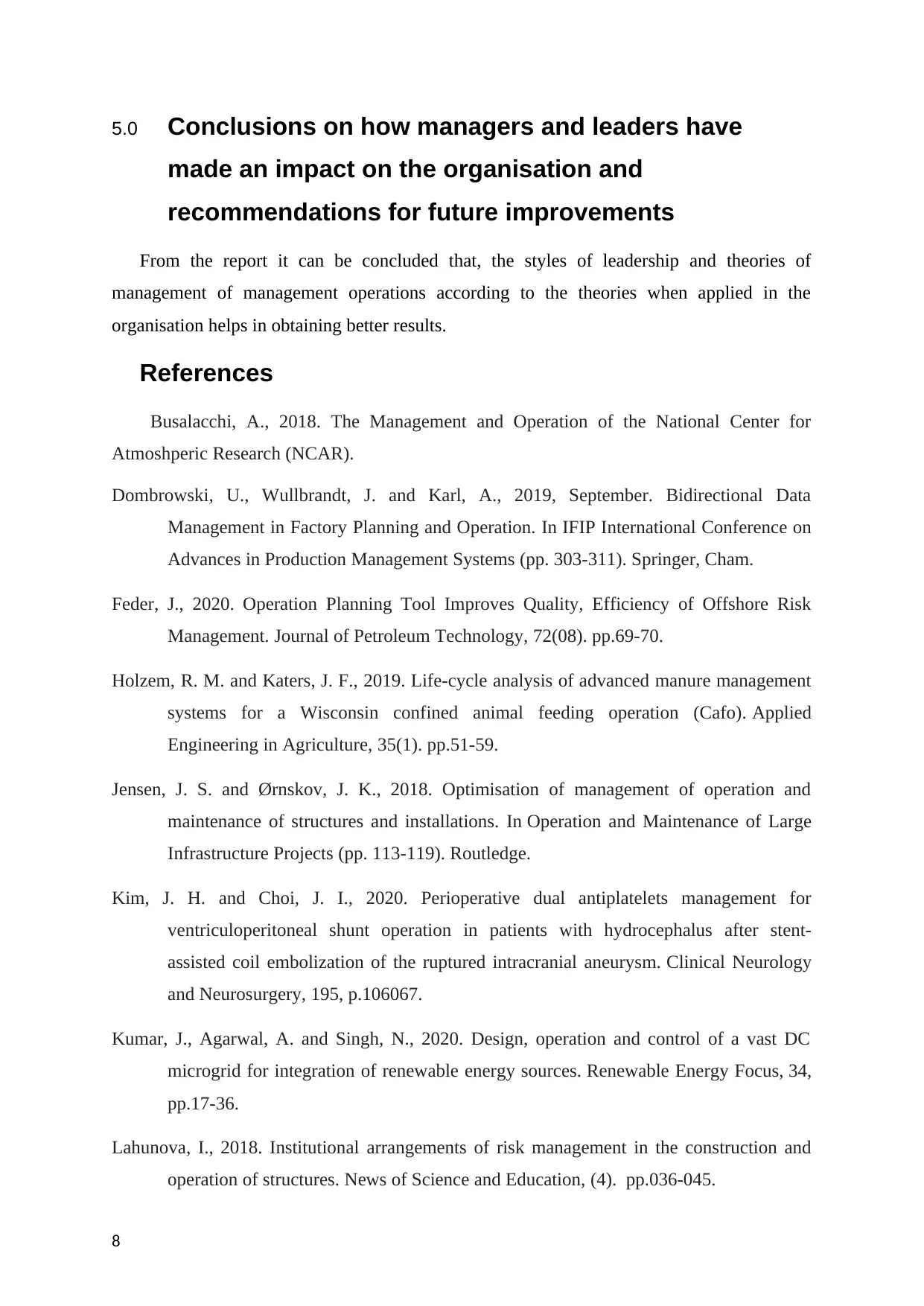
5.0 Conclusions on how managers and leaders have
made an impact on the organisation and
recommendations for future improvements
From the report it can be concluded that, the styles of leadership and theories of
management of management operations according to the theories when applied in the
organisation helps in obtaining better results.
References
Busalacchi, A., 2018. The Management and Operation of the National Center for
Atmoshperic Research (NCAR).
Dombrowski, U., Wullbrandt, J. and Karl, A., 2019, September. Bidirectional Data
Management in Factory Planning and Operation. In IFIP International Conference on
Advances in Production Management Systems (pp. 303-311). Springer, Cham.
Feder, J., 2020. Operation Planning Tool Improves Quality, Efficiency of Offshore Risk
Management. Journal of Petroleum Technology, 72(08). pp.69-70.
Holzem, R. M. and Katers, J. F., 2019. Life-cycle analysis of advanced manure management
systems for a Wisconsin confined animal feeding operation (Cafo). Applied
Engineering in Agriculture, 35(1). pp.51-59.
Jensen, J. S. and Ørnskov, J. K., 2018. Optimisation of management of operation and
maintenance of structures and installations. In Operation and Maintenance of Large
Infrastructure Projects (pp. 113-119). Routledge.
Kim, J. H. and Choi, J. I., 2020. Perioperative dual antiplatelets management for
ventriculoperitoneal shunt operation in patients with hydrocephalus after stent-
assisted coil embolization of the ruptured intracranial aneurysm. Clinical Neurology
and Neurosurgery, 195, p.106067.
Kumar, J., Agarwal, A. and Singh, N., 2020. Design, operation and control of a vast DC
microgrid for integration of renewable energy sources. Renewable Energy Focus, 34,
pp.17-36.
Lahunova, I., 2018. Institutional arrangements of risk management in the construction and
operation of structures. News of Science and Education, (4). pp.036-045.
8
made an impact on the organisation and
recommendations for future improvements
From the report it can be concluded that, the styles of leadership and theories of
management of management operations according to the theories when applied in the
organisation helps in obtaining better results.
References
Busalacchi, A., 2018. The Management and Operation of the National Center for
Atmoshperic Research (NCAR).
Dombrowski, U., Wullbrandt, J. and Karl, A., 2019, September. Bidirectional Data
Management in Factory Planning and Operation. In IFIP International Conference on
Advances in Production Management Systems (pp. 303-311). Springer, Cham.
Feder, J., 2020. Operation Planning Tool Improves Quality, Efficiency of Offshore Risk
Management. Journal of Petroleum Technology, 72(08). pp.69-70.
Holzem, R. M. and Katers, J. F., 2019. Life-cycle analysis of advanced manure management
systems for a Wisconsin confined animal feeding operation (Cafo). Applied
Engineering in Agriculture, 35(1). pp.51-59.
Jensen, J. S. and Ørnskov, J. K., 2018. Optimisation of management of operation and
maintenance of structures and installations. In Operation and Maintenance of Large
Infrastructure Projects (pp. 113-119). Routledge.
Kim, J. H. and Choi, J. I., 2020. Perioperative dual antiplatelets management for
ventriculoperitoneal shunt operation in patients with hydrocephalus after stent-
assisted coil embolization of the ruptured intracranial aneurysm. Clinical Neurology
and Neurosurgery, 195, p.106067.
Kumar, J., Agarwal, A. and Singh, N., 2020. Design, operation and control of a vast DC
microgrid for integration of renewable energy sources. Renewable Energy Focus, 34,
pp.17-36.
Lahunova, I., 2018. Institutional arrangements of risk management in the construction and
operation of structures. News of Science and Education, (4). pp.036-045.
8
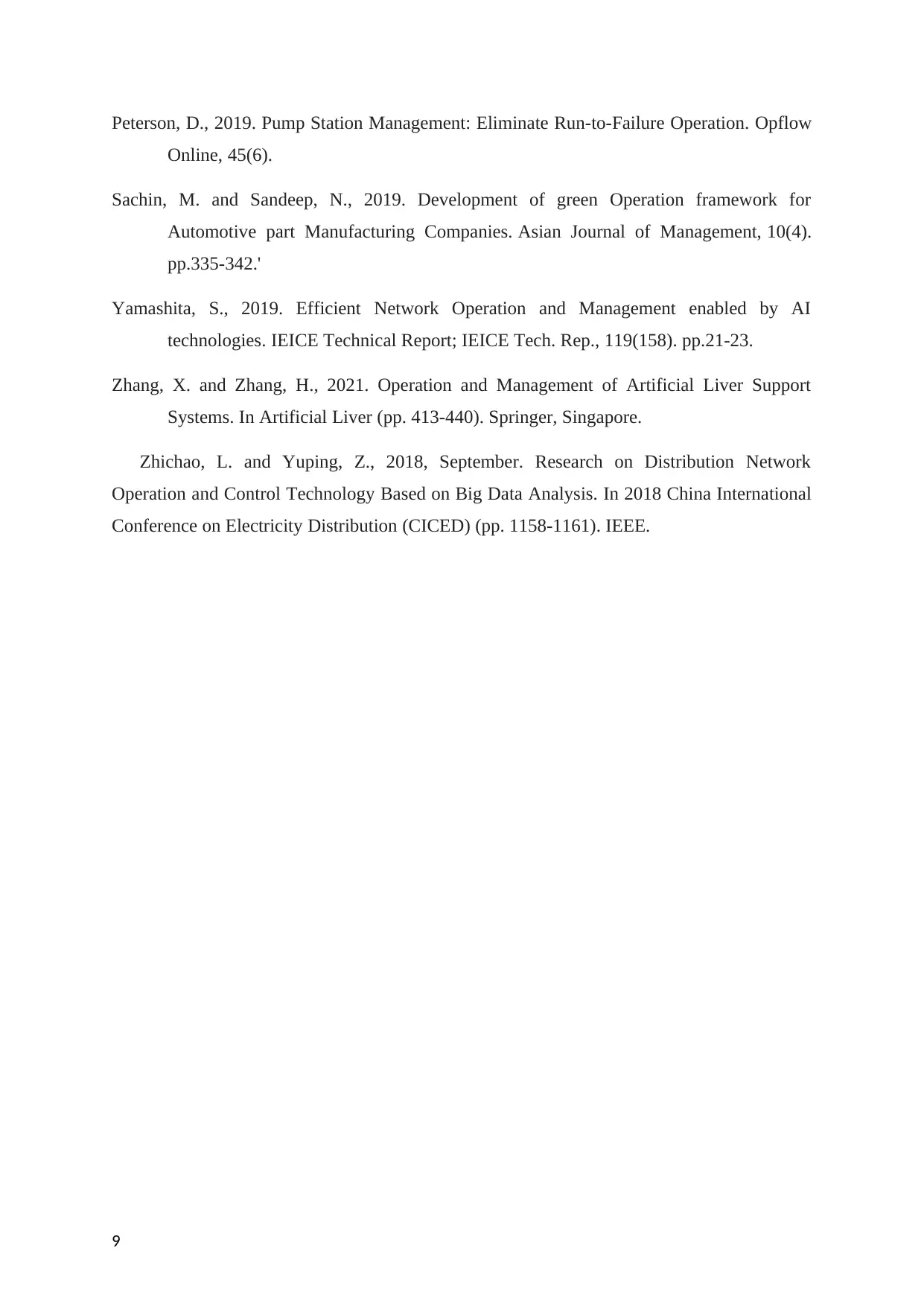
Peterson, D., 2019. Pump Station Management: Eliminate Run‐to‐Failure Operation. Opflow
Online, 45(6).
Sachin, M. and Sandeep, N., 2019. Development of green Operation framework for
Automotive part Manufacturing Companies. Asian Journal of Management, 10(4).
pp.335-342.'
Yamashita, S., 2019. Efficient Network Operation and Management enabled by AI
technologies. IEICE Technical Report; IEICE Tech. Rep., 119(158). pp.21-23.
Zhang, X. and Zhang, H., 2021. Operation and Management of Artificial Liver Support
Systems. In Artificial Liver (pp. 413-440). Springer, Singapore.
Zhichao, L. and Yuping, Z., 2018, September. Research on Distribution Network
Operation and Control Technology Based on Big Data Analysis. In 2018 China International
Conference on Electricity Distribution (CICED) (pp. 1158-1161). IEEE.
9
Online, 45(6).
Sachin, M. and Sandeep, N., 2019. Development of green Operation framework for
Automotive part Manufacturing Companies. Asian Journal of Management, 10(4).
pp.335-342.'
Yamashita, S., 2019. Efficient Network Operation and Management enabled by AI
technologies. IEICE Technical Report; IEICE Tech. Rep., 119(158). pp.21-23.
Zhang, X. and Zhang, H., 2021. Operation and Management of Artificial Liver Support
Systems. In Artificial Liver (pp. 413-440). Springer, Singapore.
Zhichao, L. and Yuping, Z., 2018, September. Research on Distribution Network
Operation and Control Technology Based on Big Data Analysis. In 2018 China International
Conference on Electricity Distribution (CICED) (pp. 1158-1161). IEEE.
9
⊘ This is a preview!⊘
Do you want full access?
Subscribe today to unlock all pages.

Trusted by 1+ million students worldwide
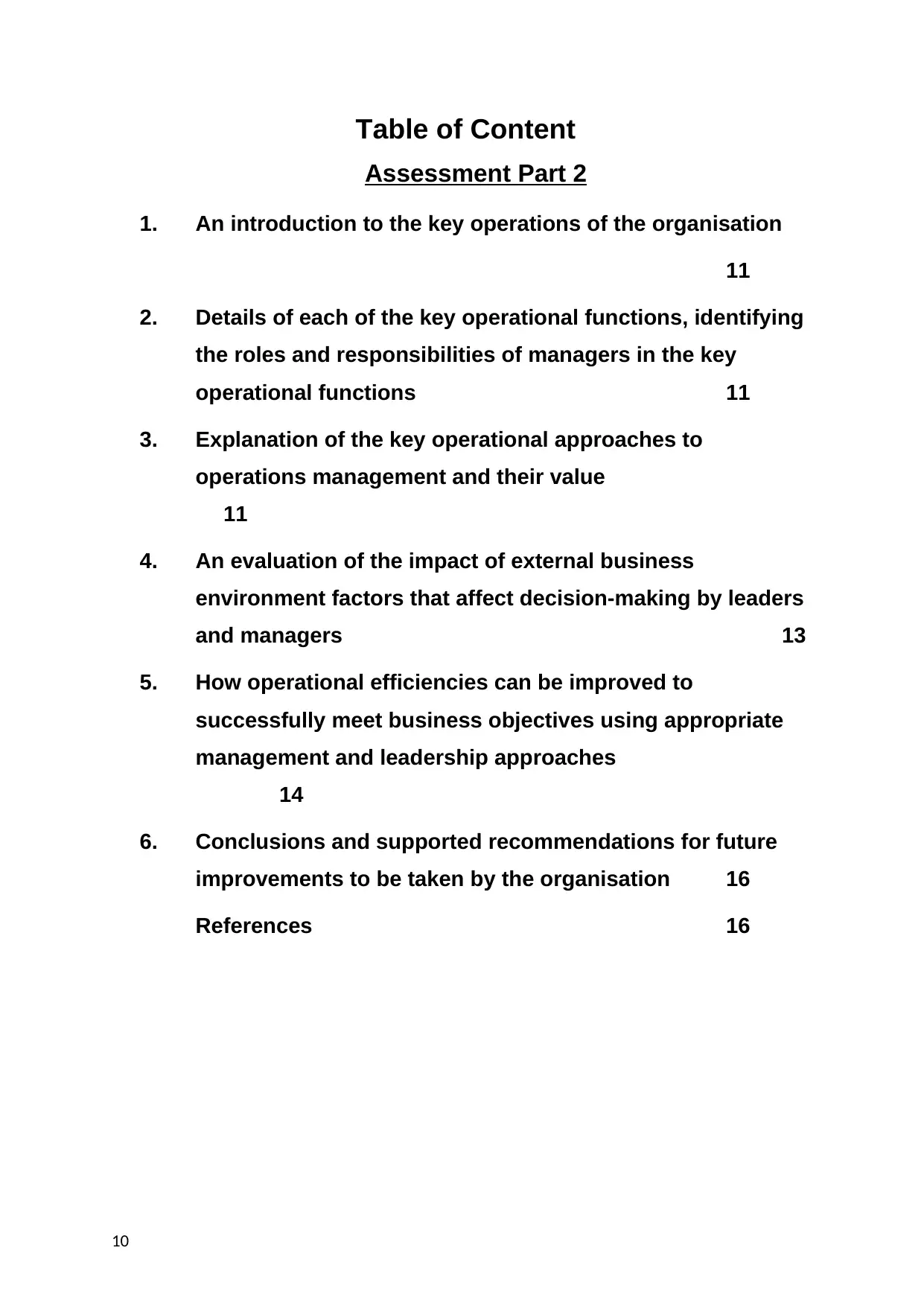
Table of Content
Assessment Part 2
1. An introduction to the key operations of the organisation
11
2. Details of each of the key operational functions, identifying
the roles and responsibilities of managers in the key
operational functions 11
3. Explanation of the key operational approaches to
operations management and their value
11
4. An evaluation of the impact of external business
environment factors that affect decision-making by leaders
and managers 13
5. How operational efficiencies can be improved to
successfully meet business objectives using appropriate
management and leadership approaches
14
6. Conclusions and supported recommendations for future
improvements to be taken by the organisation 16
References 16
10
Assessment Part 2
1. An introduction to the key operations of the organisation
11
2. Details of each of the key operational functions, identifying
the roles and responsibilities of managers in the key
operational functions 11
3. Explanation of the key operational approaches to
operations management and their value
11
4. An evaluation of the impact of external business
environment factors that affect decision-making by leaders
and managers 13
5. How operational efficiencies can be improved to
successfully meet business objectives using appropriate
management and leadership approaches
14
6. Conclusions and supported recommendations for future
improvements to be taken by the organisation 16
References 16
10
Paraphrase This Document
Need a fresh take? Get an instant paraphrase of this document with our AI Paraphraser
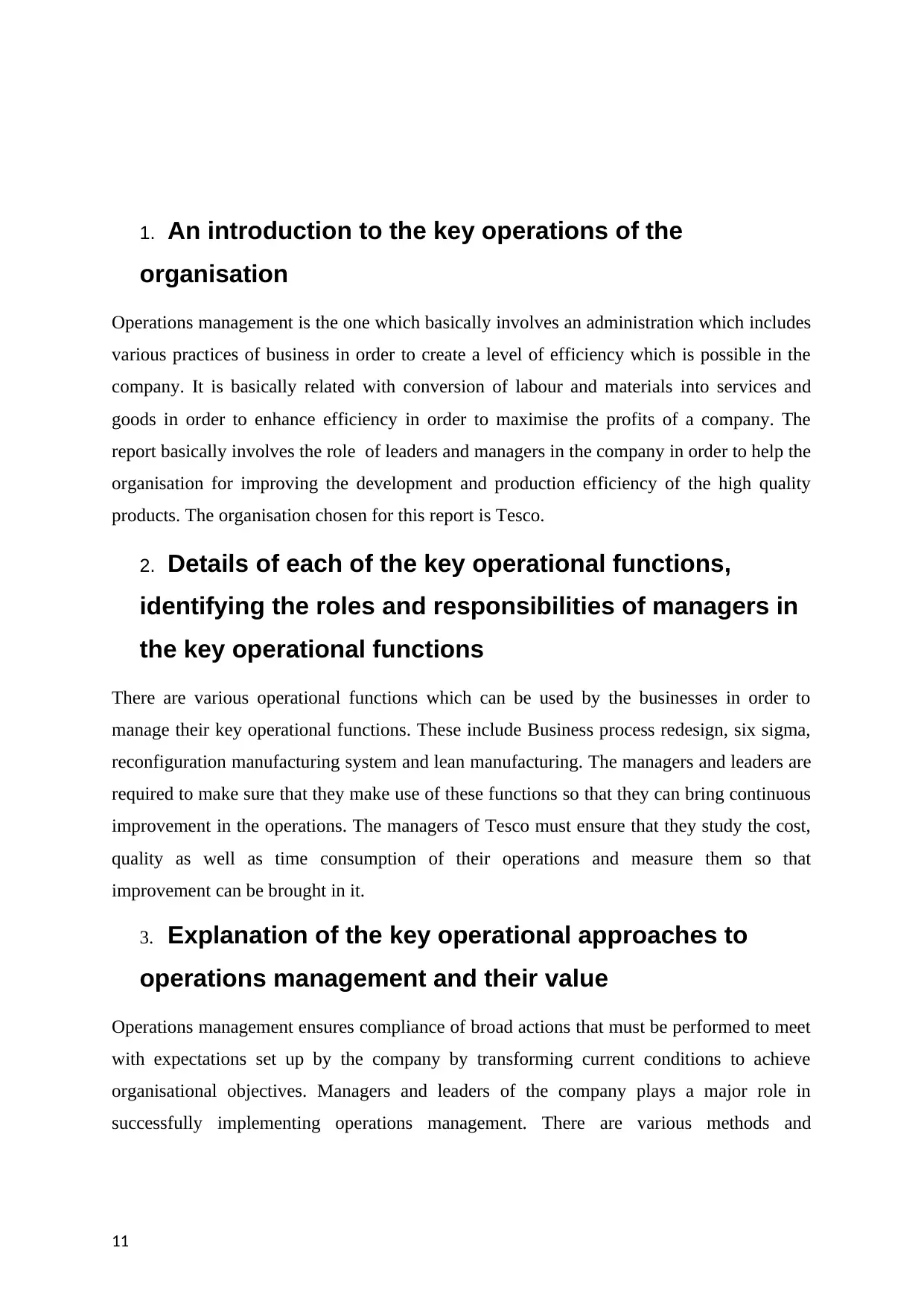
1. An introduction to the key operations of the
organisation
Operations management is the one which basically involves an administration which includes
various practices of business in order to create a level of efficiency which is possible in the
company. It is basically related with conversion of labour and materials into services and
goods in order to enhance efficiency in order to maximise the profits of a company. The
report basically involves the role of leaders and managers in the company in order to help the
organisation for improving the development and production efficiency of the high quality
products. The organisation chosen for this report is Tesco.
2. Details of each of the key operational functions,
identifying the roles and responsibilities of managers in
the key operational functions
There are various operational functions which can be used by the businesses in order to
manage their key operational functions. These include Business process redesign, six sigma,
reconfiguration manufacturing system and lean manufacturing. The managers and leaders are
required to make sure that they make use of these functions so that they can bring continuous
improvement in the operations. The managers of Tesco must ensure that they study the cost,
quality as well as time consumption of their operations and measure them so that
improvement can be brought in it.
3. Explanation of the key operational approaches to
operations management and their value
Operations management ensures compliance of broad actions that must be performed to meet
with expectations set up by the company by transforming current conditions to achieve
organisational objectives. Managers and leaders of the company plays a major role in
successfully implementing operations management. There are various methods and
11
organisation
Operations management is the one which basically involves an administration which includes
various practices of business in order to create a level of efficiency which is possible in the
company. It is basically related with conversion of labour and materials into services and
goods in order to enhance efficiency in order to maximise the profits of a company. The
report basically involves the role of leaders and managers in the company in order to help the
organisation for improving the development and production efficiency of the high quality
products. The organisation chosen for this report is Tesco.
2. Details of each of the key operational functions,
identifying the roles and responsibilities of managers in
the key operational functions
There are various operational functions which can be used by the businesses in order to
manage their key operational functions. These include Business process redesign, six sigma,
reconfiguration manufacturing system and lean manufacturing. The managers and leaders are
required to make sure that they make use of these functions so that they can bring continuous
improvement in the operations. The managers of Tesco must ensure that they study the cost,
quality as well as time consumption of their operations and measure them so that
improvement can be brought in it.
3. Explanation of the key operational approaches to
operations management and their value
Operations management ensures compliance of broad actions that must be performed to meet
with expectations set up by the company by transforming current conditions to achieve
organisational objectives. Managers and leaders of the company plays a major role in
successfully implementing operations management. There are various methods and
11
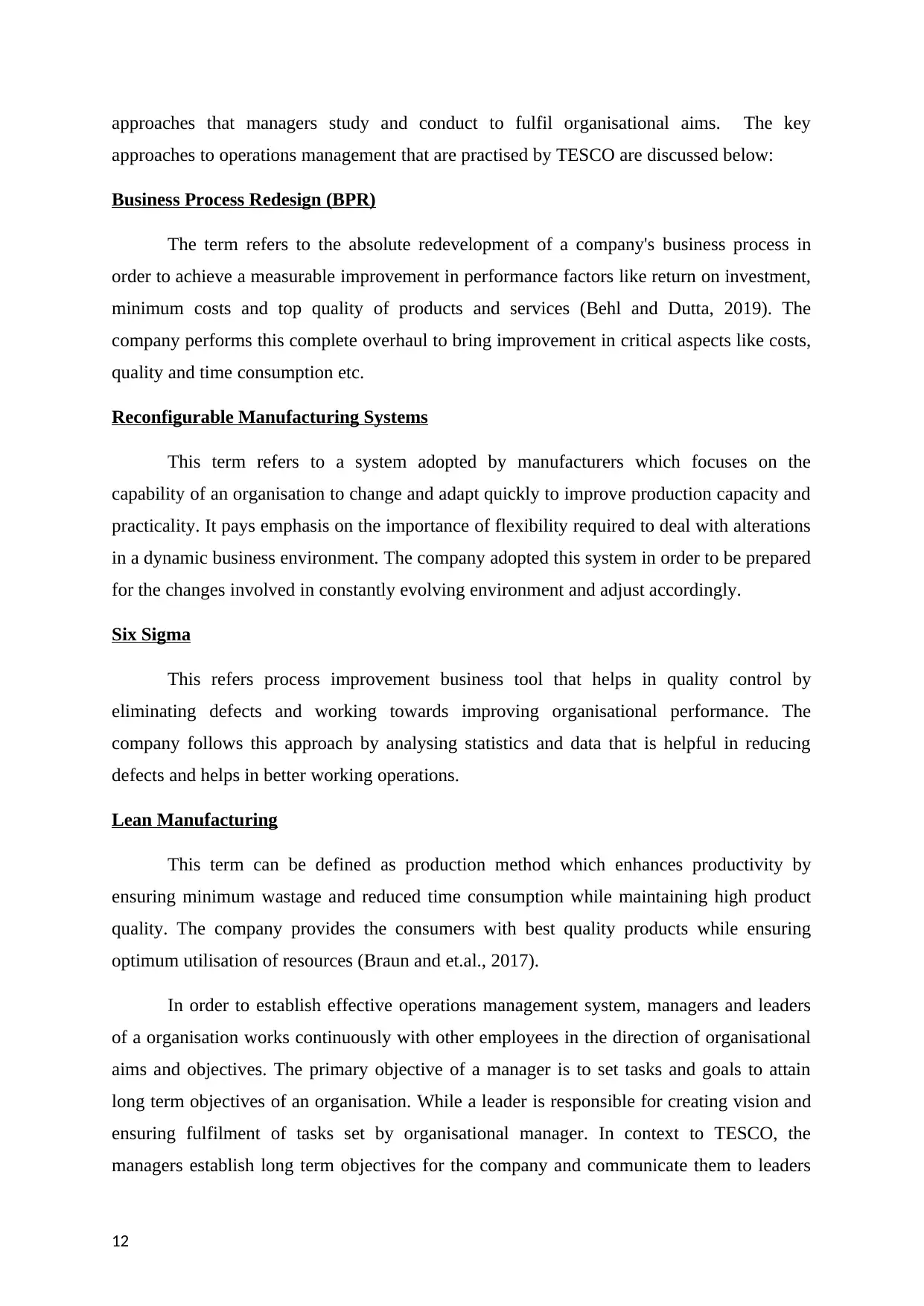
approaches that managers study and conduct to fulfil organisational aims. The key
approaches to operations management that are practised by TESCO are discussed below:
Business Process Redesign (BPR)
The term refers to the absolute redevelopment of a company's business process in
order to achieve a measurable improvement in performance factors like return on investment,
minimum costs and top quality of products and services (Behl and Dutta, 2019). The
company performs this complete overhaul to bring improvement in critical aspects like costs,
quality and time consumption etc.
Reconfigurable Manufacturing Systems
This term refers to a system adopted by manufacturers which focuses on the
capability of an organisation to change and adapt quickly to improve production capacity and
practicality. It pays emphasis on the importance of flexibility required to deal with alterations
in a dynamic business environment. The company adopted this system in order to be prepared
for the changes involved in constantly evolving environment and adjust accordingly.
Six Sigma
This refers process improvement business tool that helps in quality control by
eliminating defects and working towards improving organisational performance. The
company follows this approach by analysing statistics and data that is helpful in reducing
defects and helps in better working operations.
Lean Manufacturing
This term can be defined as production method which enhances productivity by
ensuring minimum wastage and reduced time consumption while maintaining high product
quality. The company provides the consumers with best quality products while ensuring
optimum utilisation of resources (Braun and et.al., 2017).
In order to establish effective operations management system, managers and leaders
of a organisation works continuously with other employees in the direction of organisational
aims and objectives. The primary objective of a manager is to set tasks and goals to attain
long term objectives of an organisation. While a leader is responsible for creating vision and
ensuring fulfilment of tasks set by organisational manager. In context to TESCO, the
managers establish long term objectives for the company and communicate them to leaders
12
approaches to operations management that are practised by TESCO are discussed below:
Business Process Redesign (BPR)
The term refers to the absolute redevelopment of a company's business process in
order to achieve a measurable improvement in performance factors like return on investment,
minimum costs and top quality of products and services (Behl and Dutta, 2019). The
company performs this complete overhaul to bring improvement in critical aspects like costs,
quality and time consumption etc.
Reconfigurable Manufacturing Systems
This term refers to a system adopted by manufacturers which focuses on the
capability of an organisation to change and adapt quickly to improve production capacity and
practicality. It pays emphasis on the importance of flexibility required to deal with alterations
in a dynamic business environment. The company adopted this system in order to be prepared
for the changes involved in constantly evolving environment and adjust accordingly.
Six Sigma
This refers process improvement business tool that helps in quality control by
eliminating defects and working towards improving organisational performance. The
company follows this approach by analysing statistics and data that is helpful in reducing
defects and helps in better working operations.
Lean Manufacturing
This term can be defined as production method which enhances productivity by
ensuring minimum wastage and reduced time consumption while maintaining high product
quality. The company provides the consumers with best quality products while ensuring
optimum utilisation of resources (Braun and et.al., 2017).
In order to establish effective operations management system, managers and leaders
of a organisation works continuously with other employees in the direction of organisational
aims and objectives. The primary objective of a manager is to set tasks and goals to attain
long term objectives of an organisation. While a leader is responsible for creating vision and
ensuring fulfilment of tasks set by organisational manager. In context to TESCO, the
managers establish long term objectives for the company and communicate them to leaders
12
⊘ This is a preview!⊘
Do you want full access?
Subscribe today to unlock all pages.

Trusted by 1+ million students worldwide
1 out of 17
Related Documents
Your All-in-One AI-Powered Toolkit for Academic Success.
+13062052269
info@desklib.com
Available 24*7 on WhatsApp / Email
![[object Object]](/_next/static/media/star-bottom.7253800d.svg)
Unlock your academic potential
Copyright © 2020–2025 A2Z Services. All Rights Reserved. Developed and managed by ZUCOL.





